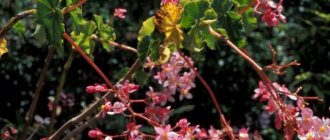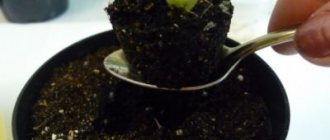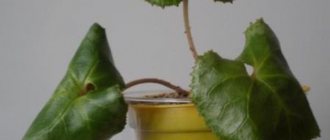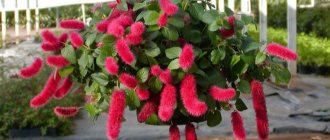To decorate an apartment or office, it is not necessary to hang expensive paintings on the walls or place figurines; exotic flowers growing in tubs or pots create a unique atmosphere in the room
Cotyledon has excellent decorative qualities. The succulent, which is not without reason called the silver crown, grows wild on the Arabian Peninsula and is found in southern Africa.
This perennial from the Tolstyankov family unites up to 40 species of low shrubs with fragile stems. Cotyledon produces flower stalks from rosettes of fleshy leaves located oppositely, or directly from the tops.
Popular types
The height of succulents from the Crassulaceae family rarely exceeds 70 cm; the stems of some shrubs have a light green tint, while others have a reddish or dark gray color . Depending on the type, cotyledon leaves are round or have the following shape:
- oval;
- rhombus;
- triangle.
They are attached to the stem by petioles and are covered with a large number of villi. The tubular flowers with white or orange petals, which appear as early as March, are borne in panicles .
Cotyledon rounded
Succulent cotyledon orbiculata in the wild grows up to 90–100 cm, but when planted in a room it becomes a compact bush with spreading shoots , which are decorated with flat oblong or rounded slightly flattened leaves covered with a purine coating.
They differ not only in shape, but also have different shades :
- soft blue;
- bright orange;
- light green;
- dark burgundy.
Cotyledon orbicularis produces a long peduncle with yellow or reddish petals. the bright border framing the edges of the leaves is especially striking .
Cotyledon wavy
Undulata or in Latin ocotyledon undulata is an ornamental shrub with diamond-shaped leaves of silver color .
The original shade is given to them by a waxy coating covering the smooth surface. Cotyledon wavy produces a peduncle with white stripes , which are also located on bell-shaped buds with bright orange petals. The leaves are decorated with wavy edges, the height of the succulent does not exceed 80 cm.
Cotyledon felt
Cotyledon tomentosa is distinguished by its miniature size; the bush is formed from branched shoots with whitish pubescence. The fleshy light green leaves have an original shape and end in growths on top.
The felted type of cotyledon is often called "bear claw" . A bell-shaped inflorescence with bright red petals appears from the succulent rosette.
Lady Smith
Cotyledon Ladismithiensis has a decorative appearance. The fleshy leaves of a low compact bush are covered with dense silvery hairs .
Bright petals are collected in bell-shaped inflorescences , which stand out in an original way among the delicate greenery.
Cotyledon Levisia
The perennial cotiledon lewisia has an amazing appearance. Pink or white flowers have many petals.
The leaves of Cotyledon Levisia, with a smooth surface and wavy edges , are collected in an attractive rosette with a dark red border.
Important! The succulent produces not one, but several flower stalks.
Cotyledon grandiflora
Compared to other varieties, the exotic perennial is distinguished by its decent growth, its height reaches 80 cm.
Cotyledon macrantha berger has straight, thick, oval-shaped branches on which are located fleshy green leaves, decorated with a burgundy-colored border.
Long peduncles produce drooping tubular bells with bright petals .
Cotyledon papillaris
Creeping shrubs are also found among succulents; they look very elegant and are especially popular among flower lovers.
Interesting! Young stems of cotyledon papillaris have a pink tint; in mature plants they become green.
The thickness of the fleshy and long leaves with reddish ends reaches almost half a centimeter. The shrub is covered with a bluish bloom and produces yellow flowers with papillae.
tree-like
Although most succulents are herbaceous plants, in many apartments you can find cotyledon, reaching a height of 1-1.2 m . A neat tree with many branches is planted in the hope that it will bring wealth. The tree-like succulent has beautiful thick leaves with a round shape.
Saxifrage
The entire above-ground part of this perennial from the Crassulaceae family is covered with thick fibers. The flattened leaves of the low cotyledon form a dense rosette at the very roots . At the beginning of June, saxifrage produces a peduncle on which white buds appear.
Cotyledon colloidal
The unusual appearance of the shrub, whose shoots branch from the ground, attracts attention. Reddish leaves are located on slightly curved stems . The same bright buds appear on a long peduncle and resemble tongues of fire, but it is difficult to convey this beauty in a photo.
Decorativeness
Cotyledon flowers most often come in shades of yellow, pink and orange. There are white, red and greenish ones. Peduncles can grow from the top of the plant, or appear from the center of the rosettes.
In the large-flowered cotyledon (Macrantha), the peduncle extends up to 90 cm. At its top, an umbrella-shaped inflorescence with orange bells is formed. All cotyledons of the Crassulaceae family have a similar flower shape.
Flowering time depends on the specific species. The main attraction of this houseplant is its fleshy leaves, so with proper care at home it is decorative all year round.
Popular types of cotyledon have leaves:
- rounded;
- rounded triangular;
- cylindrical;
- wavy;
- with teeth on the edges, similar to claws.
Most often they are pale green with a waxy coating, or covered with villi. Both the bloom and hair of succulents in their natural environment help retain moisture and reflect direct sunlight.
Care
Exotic succulents are often planted in apartments and offices. Although cotyledons grow in completely different conditions in the wild, they take root well in the room and delight with their decorative appearance.
Watering
Succulents are adapted to drought and are accustomed to storing water in their tissues. If the apartment is cool in winter, the bushes do not need to be moistened. In summer , water the soil in the pot only when it is completely dry. You should not allow liquid to stagnate in the substrate, as this can lead to rotting of the roots.
Advice ! Water for irrigation should be settled, and not used immediately from the tap.
Illumination
The African guest loves the sun and adores direct rays. The succulent is most comfortable on a south window. You cannot plant cotyledon on the north side ; it is not a fact that it will bloom when placed with access to the west or east.
Attention! With a lack of light, the shoots of the bush become elongated and the leaves lose their decorative appearance.
Temperature
In summer, 18° is enough for cotyledon, but the succulent is also comfortable at 28 degrees. In the warm season, it is better to take the pot with the plant into the loggia or onto the balcony , where fresh air comes in.
Cotyledon overwinters well at temperatures not lower than 10, but not higher than 16. If the room is too cold, the leaves wither. Cotyledon does not bloom when it was very warm during the dormant period .
Humidity
Under natural conditions, the succulent grows in tropical deserts, where not a drop of rain falls on the ground for months; the shrub has adapted to an arid climate . Cotyledon develops normally in low humidity environments.
The soil
In the wild, the succulent grows on sand or nestles on rocks. A cactus substrate diluted with fine expanded clay is suitable for planting it. It’s easy to prepare the soil at home ; to do this, mix the following in equal parts:
- gravel;
- river sand;
- turf and leaf soil.
A little wood ash , which contains various microelements, and bone meal, rich in phosphorus, are added to the soil.
Attention! Cotyledon takes root well in loose, but not very fertile soil.
Transfer
The exotic shrub develops slowly, small roots do not take up much space in the pot, but the crown grows. If it goes beyond the boundaries of the container, the flower is replanted by selecting a larger container. The succulent needs this procedure no more than once every 2-3 years.
This video shows how to replant Cotyledon.
Fertilizer
Since cotyledon naturally grows in poor soil, it does not need to be particularly fed. In winter, the succulent should rest, and in summer and spring, the substrate in the pot is fertilized three times with a ready-made complex for cacti, which is sold in a gardening store.
Relationship between irrigation regime and air temperature and lighting
It is not difficult to arrange watering of cotyledon if you remember the main principle: this plant takes water from the soil only during the active period, under conditions of high air temperature and bright lighting. Therefore, it is necessary to organize irrigation based on the following parameters:
| Life cycle phase | Temperature | Light intensity | Soil condition |
| During periods of growth of shoots and leaves, as well as during the flowering phase, watering is regular. During the resting phase, cotyledons can be left for a long time without watering. | At low temperatures, watering is not carried out. In moderate cases, they are carried out regularly, but carefully. At high levels they may be more frequent. | When kept in partial shade, watering should be less frequent than when placing the plant in full sun or under a phytolamp. | As long as there is even slight moisture in the soil, watering is not carried out. It is permissible to irrigate only after the soil clod has completely dried. |
All these parameters should be considered not individually, but together. For example, if the cotyledon is actively growing and the soil in the pot is completely dry, but the weather is cool and cloudy, watering should be postponed.
Water the cotyledons very carefully, along the edge of the pot, without touching the leaves. The water should be warm and soft.
Bloom
Only if the care requirements are met, with sufficient lighting and proper placement, the cotyledon acquires a decorative appearance, and starting in March, long flower stalks appear on which buds form.
Although the succulent is easy to care for , if one of the conditions is not met, you should not expect it to bloom.
How to grow Cotyledon tomentosa at home
This plant is quite easy to care for even for a beginner. You just have to take into account some points that we will describe below and your succulent will delight you with its presence for a long time. The main thing to consider is that Cotledon is native to South Africa (the southern hemisphere of the Earth). Its dormant period begins in summer and partly in winter (when it gets hot in its homeland), and its growth period occurs in the spring and autumn months. But in the first year it is worth observing your flower to determine when it begins a period of active growth in your indoor microclimate, and when it goes into a dormant state. This will be the starting point for further care of your succulent.
Growing cotyledon from seeds
You can plant decorative perennials in a room using one of the following methods. The simplest option involves sowing seeds. They are sold in a flower shop ; the annotation to the package contains a planting diagram. Place the seeds in small bowls filled with 1 part leaf soil and ½ sand, lightly sprinkling the same soil on top. The containers are covered with glass. When the seedlings grow, they are planted in pots .
Varieties
Currently, the genus includes 10 plant species. Previously, it was more numerous, but after a taxonomic revision in the 80s of the 20th century, most of the species were assigned to the genera Tilecodon, Adromiscus, Dudleya, Crassula and Echeveria.
Bibliography:
- All about succulents / McCallister. R. - St. Petersburg: LLC "SZKEO "Crystal", 2007. - 208 p.: ill.
- Agaves, aloe and other succulents / Udalova R.A. - St. Petersburg: Agropromizdat, 1994. - 112 p.: ill.
Propagation of cotyledon by cuttings and leaves
To grow a succulent from seeds, you have to create a greenhouse effect, constantly spray and ventilate the hatched sprouts. Cotyledon can be propagated by separating a cutting from the stem . After drying, it is planted in a moist substrate.
A succulent made from leaves takes root well ; for this purpose, select specimens without stains or damage and with a uniform color:
- Break off the stem with your fingers.
- Dry the broken areas.
- Treated in a growth stimulator.
- Place on wet sand, scar side up.
a container with a sheet of cotyledon on the window, covering it with a curtain, and constantly moisten the substrate. After a month, roots should appear.
Description of the plant
The roots of the plant are fibrous, they are located closer to the surface, the stems emerging from the root are juicy and fleshy. The growth rate is slow; in general, the height of the cotyledon plant can range from 30 to 70 cm.
- The leaves and stems are colored in shades of green turning to burgundy. The shade of the ground part can also change with age; they begin to become tree-like and acquire the appropriate color.
- But the shape of the leaves can vary greatly depending on the variety and variety; they can be triangular, round, diamond-shaped, or lancet-shaped.
We recommend that you read the article: Yucca plant description.
The coloring is also different, young ones are green, maybe with a colored outline or spots, mature ones take on the tone of wood.
All varieties of cotyledon have fleshy, juicy leaves, the skin is covered with white fluff.
From mid-spring to late summer you can enjoy flowering. The inflorescence forms a bouquet of small bells, rising 30 cm above the leaves. Their petals are dense, glossy, as if they were not real, and their colors come in three shades of white, yellow or orange.











